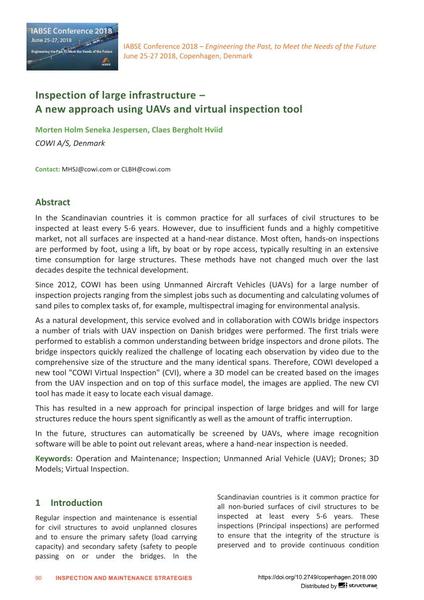Inspection of large infrastructure – A new approach using UAVs and virtual inspection tool

|
|
|||||||||||
Détails bibliographiques
| Auteur(s): |
Morten Holm Seneka Jespersen
(COWI A/S, Denmark)
Claes Bergholt Hviid (COWI A/S, Denmark) |
||||
|---|---|---|---|---|---|
| Médium: | papier de conférence | ||||
| Langue(s): | anglais | ||||
| Conférence: | IABSE Conference: Engineering the Past, to Meet the Needs of the Future, Copenhagen, Denmark, 25-27 June 2018 | ||||
| Publié dans: | IABSE Conference Copenhagen 2018 | ||||
|
|||||
| Page(s): | 90-96 | ||||
| Nombre total de pages (du PDF): | 7 | ||||
| DOI: | 10.2749/copenhagen.2018.090 | ||||
| Abstrait: |
In the Scandinavian countries it is common practice for all surfaces of civil structures to be inspected at least every 5-6 years. However, due to insufficient funds and a highly competitive market, not all surfaces are inspected at a hand-near distance. Most often, hands-on inspections are performed by foot, using a lift, by boat or by rope access, typically resulting in an extensive time consumption for large structures. These methods have not changed much over the last decades despite the technical development. Since 2012, COWI has been using Unmanned Aircraft Vehicles (UAVs) for a large number of inspection projects ranging from the simplest jobs such as documenting and calculating volumes of sand piles to complex tasks of, for example, multispectral imaging for environmental analysis. As a natural development, this service evolved and in collaboration with COWIs bridge inspectors a number of trials with UAV inspection on Danish bridges were performed. The first trials were performed to establish a common understanding between bridge inspectors and drone pilots. The bridge inspectors quickly realized the challenge of locating each observation by video due to the comprehensive size of the structure and the many identical spans. Therefore, COWI developed a new tool "COWI Virtual Inspection" (CVI), where a 3D model can be created based on the images from the UAV inspection and on top of this surface model, the images are applied. The new CVI tool has made it easy to locate each visual damage. This has resulted in a new approach for principal inspection of large bridges and will for large structures reduce the hours spent significantly as well as the amount of traffic interruption. In the future, structures can automatically be screened by UAVs, where image recognition software will be able to point out relevant areas, where a hand-near inspection is needed. |
||||
